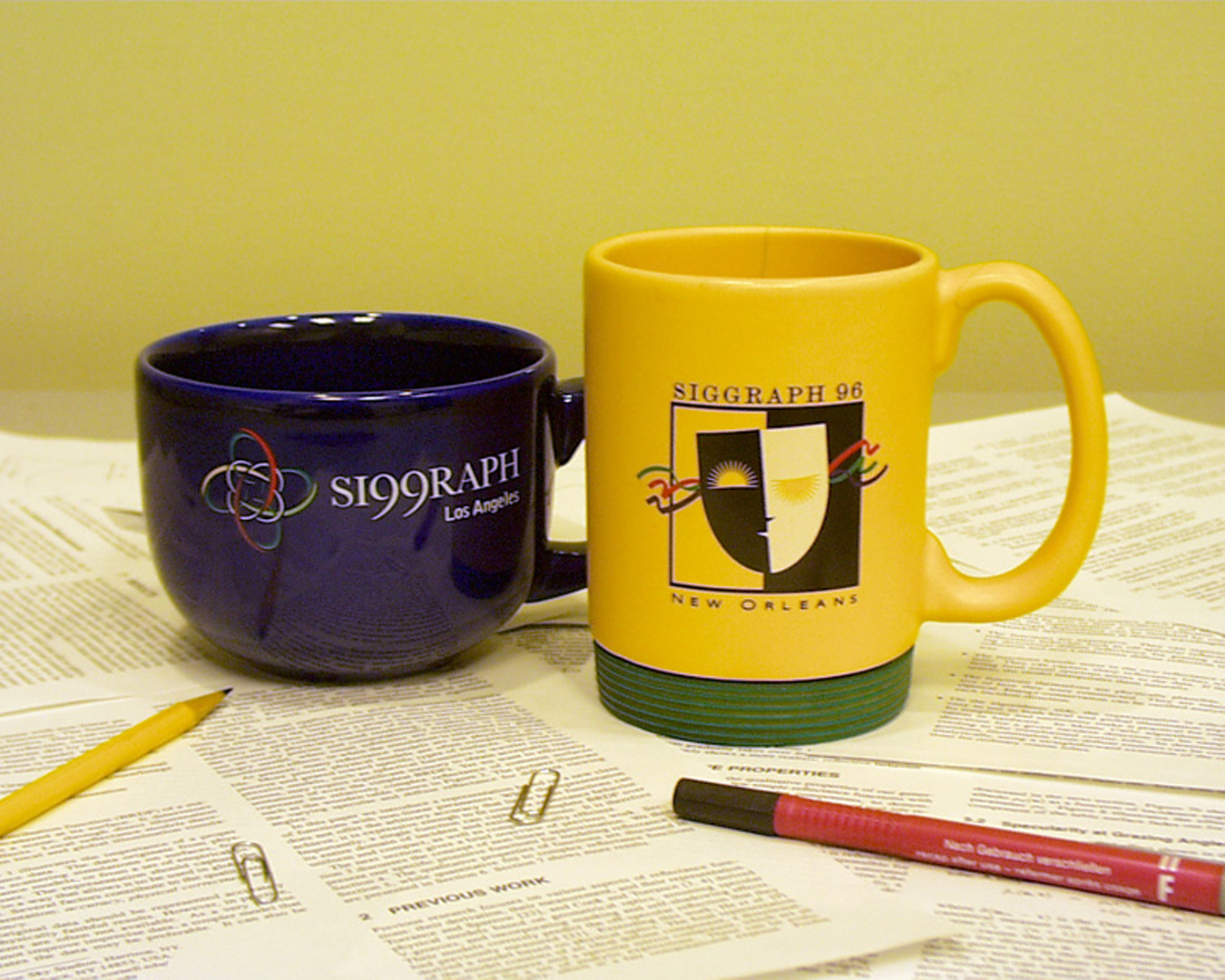“Toward a psychophysically-based light reflection model for image synthesis” by Pellacini, Ferwerda and Greenberg
Conference:
Type(s):
Title:
- Toward a psychophysically-based light reflection model for image synthesis
Presenter(s)/Author(s):
Abstract:
In this paper we introduce a new light reflection model for image synthesis based on experimental studies of surface gloss perception. To develop the model, we’ve conducted two experiments that explore the relationships between the physical parameters used to describe the reflectance properties of glossy surfaces and the perceptual dimensions of glossy appearance. In the first experiment we use multidimensional scaling techniques to reveal the dimensionality of gloss perception for simulated painted surfaces. In the second experiment we use magnitude estimation methods to place metrics on these dimensions that relate changes in apparent gloss to variations in surface reflectance properties. We use the results of these experiments to rewrite the parameters of a physically-based light reflection model in perceptual terms. The result is a new psychophysically-based light reflection model where the dimensions of the model are perceptually meaningful, and variations along the dimensions are perceptually uniform. We demonstrate that the model can facilitate describing surface gloss in graphics rendering applications. This work represents a new methodology for developing light reflection models for image synthesis.
References:
1. Aida, T. (1997) Glossiness of colored papers and its application to specular glossiness measuring instruments. Systems and Computers in Japan, 28(1), 1106-1118.
2. American Society for Testing and Materials. (1989) Standard practice for establishing color and gloss tolerances (Designation: D3134-89). Annual Book of ASTM Standards, 324-329.
3. Billmeyer, F.W. and O’Donnell, F.X.D. (1987) Visual gloss scaling and multidimensional scaling analysis of painted specimens. Color Res. App. 12(6), 315-326.
4. Blake, A. and Bulthofl, H. (1990)Does the brain know the physics of specular reflection? Nature, 343, 165-168.
5. Blinn, J.F. (1977) Models of light reflection for computer synthesized pictures. Computer Graphics (SIGGRAPH 77 Conference Proceedings), 11 (4), 192- 198.
6. Borg, I. and Groenen, P. (1997) Modern Multidimensional Sealing: Theory and Applications. Springer: New York.
7. Braje, W. L. and Knill, D. C. (1994) Apparent surface shape affects perceived specular reflectance of curved surfaces. Invest. Ophth. Vis. Sci. Suppl. 35(4), 1628.
8. Busing, F., Commandeur, J., and Heiser, W. (1997) PROXSCAL: a multidimensional scaling program for individual differences scaling with constraints. In W. Bandilla and Faulbaum (Eds.), Advances in Statistical Software, 6, Lucius & Lucius: Stuttgart, 67-73.
9. Cook, R.L. and Torrance, K.E. (1981) A reflectance model for computer graphics. Computer Graphics (SIGGRAPH 81 Conference Proceedings), 15(4), 187- 196.
10. Fairchild, M.D. (1998) Color Appearance Models. Addison-Wesley, Reading, MA.
11. He, X.D., Torrance, K.E., Sillion, F.X., and Greenberg, D.P. (1991) A comprehensive physical model for light reflection. Computer Graphics (SIGGRAPH 91 Conference Proceedings), 25(4), 175- 186.
12. Helmholtz, H. von (1924) Treatise on Physiological Optics (vol. II), (Trans. by J.P. Southhall). Optical Society of America.
13. Hering, E. (1964) Outlines of a Theory of the Light Sense, (Trans. by L. Hurvich and D. Jameson). Harvard University Press: Cambridge, MA.
14. Hunter, R.S. and Harold R.W. (1987) The Measurement of Appearance (2nd edition). Wiley, New York.
15. Judd, D.B. (1937) Gloss and glossiness. Am. Dyest. Rep. 26, 234-235.
16. Lafortune, E.P., Foo, S.C., Torrance, K.E., and Greenberg, D.P. (1997) Non-linear approximation of reflectance functions. SIGGRAPH 97 Conference Proceedings, 117-126.
17. Mingolla, E. and Todd, J.T. (1986) Perception of solid shape from shading. Bio. Cyber. 53(3), 137-151.
18. Nishida, S. and Shinya, M. (1998) Use of image-based information in judgements of surface reflectance properties. J. Opt. Soc. Am., 15(12), 2951-2965.
19. Pattanaik. S. Ferwerda, J.A., Fairchild, M.D. and Greenberg, D.P. (1998) A multiscale model of adaptation and spatial vision for realistic image display. SIGGRAPH 98 Conference Proceedings, 287- 298.
20. Phong B.T. (1975) Illumination for computer generated pictures. Comm. ACM 18(6), 311-317.
21. Schlick, C. (1993) A customizable reflectance model for everyday rendering. Proc. 4th Eurographics Workshop on Rendering, 73-83.
22. Stamm, J. (1999)Difl?action shaders. SIGGRAPH 99 Conference Proceedings, 101-110.
23. Strauss, P. S. (1990) A realistic lighting model for computer animators. IEEE Comp. Graph. & Appl. 10(6), 56-64.
24. Todd, J.T. and Mingolla, E. (1983)Perception of surface curvature and direction of illumination from patterns of shading. J. Exp. Psych.: Hum. Percept. and Perf. 9(4), 583-595.
25. Torgerson, W.S. (1960) Theory and Methods” of Scaling. Wiley: New York.
26. Tumblin, J., Hodgins J.K., and Guenter, B.K. (1999) Two methods for display of high contrast images. ACM Trans. on Graph., 18(1), 56-94
27. Ward, G.J. (1992) Measuring and modeling anisotropic reflection. Computer Graphics (SIGGRAPH 92 Conference Proceedings), 26(2), 265- 272.
28. Ward-Larson, G., Rushmeier H., and Piatko, C. (1997) A visibility matching tone reproduction operator for high dynamic range scenes. IEEE Trans. on Vis. and Comp. Graph., 3(4):291-306.
29. Wyszecki, G. and Stiles, W.S. (1982) Color Science: Concepts” and Methods’, Quantitative Data and Formulae (2nd ed.), Wiley: New York.




